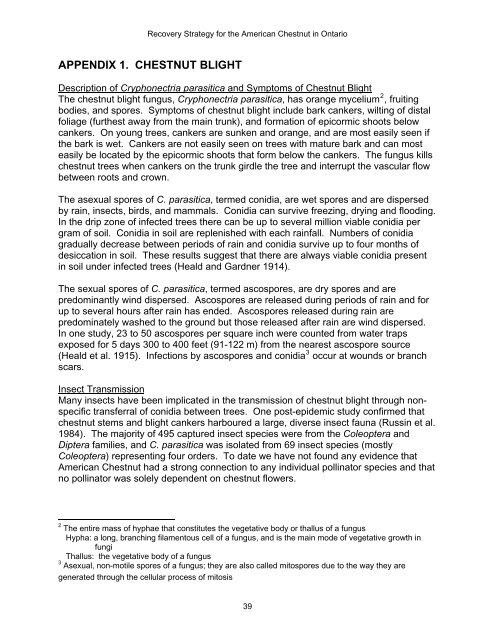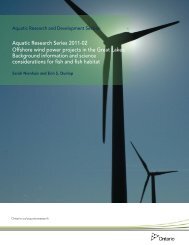(Castanea dentata) in Ontario - Ministry of Natural Resources ...
(Castanea dentata) in Ontario - Ministry of Natural Resources ...
(Castanea dentata) in Ontario - Ministry of Natural Resources ...
You also want an ePaper? Increase the reach of your titles
YUMPU automatically turns print PDFs into web optimized ePapers that Google loves.
Recovery Strategy for the American Chestnut <strong>in</strong> <strong>Ontario</strong><br />
APPENDIX 1. CHESTNUT BLIGHT<br />
Description <strong>of</strong> Cryphonectria parasitica and Symptoms <strong>of</strong> Chestnut Blight<br />
The chestnut blight fungus, Cryphonectria parasitica, has orange mycelium 2 , fruit<strong>in</strong>g<br />
bodies, and spores. Symptoms <strong>of</strong> chestnut blight <strong>in</strong>clude bark cankers, wilt<strong>in</strong>g <strong>of</strong> distal<br />
foliage (furthest away from the ma<strong>in</strong> trunk), and formation <strong>of</strong> epicormic shoots below<br />
cankers. On young trees, cankers are sunken and orange, and are most easily seen if<br />
the bark is wet. Cankers are not easily seen on trees with mature bark and can most<br />
easily be located by the epicormic shoots that form below the cankers. The fungus kills<br />
chestnut trees when cankers on the trunk girdle the tree and <strong>in</strong>terrupt the vascular flow<br />
between roots and crown.<br />
The asexual spores <strong>of</strong> C. parasitica, termed conidia, are wet spores and are dispersed<br />
by ra<strong>in</strong>, <strong>in</strong>sects, birds, and mammals. Conidia can survive freez<strong>in</strong>g, dry<strong>in</strong>g and flood<strong>in</strong>g.<br />
In the drip zone <strong>of</strong> <strong>in</strong>fected trees there can be up to several million viable conidia per<br />
gram <strong>of</strong> soil. Conidia <strong>in</strong> soil are replenished with each ra<strong>in</strong>fall. Numbers <strong>of</strong> conidia<br />
gradually decrease between periods <strong>of</strong> ra<strong>in</strong> and conidia survive up to four months <strong>of</strong><br />
desiccation <strong>in</strong> soil. These results suggest that there are always viable conidia present<br />
<strong>in</strong> soil under <strong>in</strong>fected trees (Heald and Gardner 1914).<br />
The sexual spores <strong>of</strong> C. parasitica, termed ascospores, are dry spores and are<br />
predom<strong>in</strong>antly w<strong>in</strong>d dispersed. Ascospores are released dur<strong>in</strong>g periods <strong>of</strong> ra<strong>in</strong> and for<br />
up to several hours after ra<strong>in</strong> has ended. Ascospores released dur<strong>in</strong>g ra<strong>in</strong> are<br />
predom<strong>in</strong>ately washed to the ground but those released after ra<strong>in</strong> are w<strong>in</strong>d dispersed.<br />
In one study, 23 to 50 ascospores per square <strong>in</strong>ch were counted from water traps<br />
exposed for 5 days 300 to 400 feet (91-122 m) from the nearest ascospore source<br />
(Heald et al. 1915). Infections by ascospores and conidia 3 occur at wounds or branch<br />
scars.<br />
Insect Transmission<br />
Many <strong>in</strong>sects have been implicated <strong>in</strong> the transmission <strong>of</strong> chestnut blight through nonspecific<br />
transferral <strong>of</strong> conidia between trees. One post-epidemic study confirmed that<br />
chestnut stems and blight cankers harboured a large, diverse <strong>in</strong>sect fauna (Russ<strong>in</strong> et al.<br />
1984). The majority <strong>of</strong> 495 captured <strong>in</strong>sect species were from the Coleoptera and<br />
Diptera families, and C. parasitica was isolated from 69 <strong>in</strong>sect species (mostly<br />
Coleoptera) represent<strong>in</strong>g four orders. To date we have not found any evidence that<br />
American Chestnut had a strong connection to any <strong>in</strong>dividual poll<strong>in</strong>ator species and that<br />
no poll<strong>in</strong>ator was solely dependent on chestnut flowers.<br />
2 The entire mass <strong>of</strong> hyphae that constitutes the vegetative body or thallus <strong>of</strong> a fungus<br />
Hypha: a long, branch<strong>in</strong>g filamentous cell <strong>of</strong> a fungus, and is the ma<strong>in</strong> mode <strong>of</strong> vegetative growth <strong>in</strong><br />
fungi<br />
Thallus: the vegetative body <strong>of</strong> a fungus<br />
3 Asexual, non-motile spores <strong>of</strong> a fungus; they are also called mitospores due to the way they are<br />
generated through the cellular process <strong>of</strong> mitosis<br />
39
















